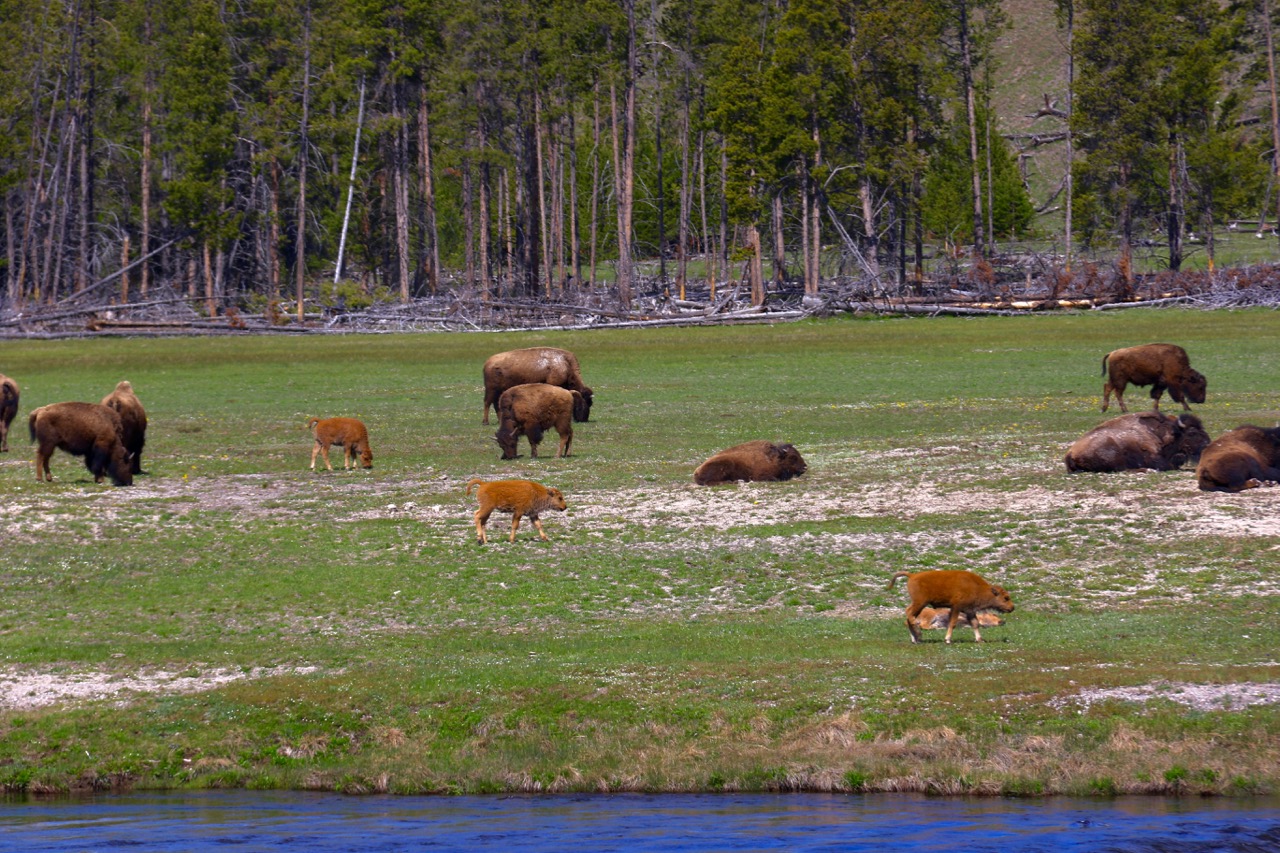Once the final, heavy snows of spring fall on Yellowstone, the desolate, tundra-like terrain of America’s first National Park starts to transform into a visual wonderland of awesomeness. If you haven’t yet seen this majestic park during the spring months, you are missing out on one of the most unique experiences in America.
As the temperature increases, the valleys, once filled with neck deep snow, start to melt out. The white landscape changes to a muddy brown, then erupts into nearly endless fields of green, interrupted only by raging rivers, energetic wildlife and gorgeous wildflowers. Spring is also when the roads to the interior of the park open to vehicle traffic, making this the perfect time to visit this iconic landscape. While there are literally millions of reasons to visit Yellowstone in the spring, I have laid out six of my favorites, which are sure to get you planning on a long weekend trip to the 3,500 square mile park.

Red Dogs
At the end of April, bison start having babies, which are called red dogs. Small, red and freaking adorable beyond words, these tiny bison will triple in size by the end of the fall months. In the spring, they bound around without a care in the world, following their parents and enjoying the first few weeks of life. Best seen in Hayden and Lamar Valley, bison are spread throughout the park and the return of the babies is an event that even the most jaded of Yellowstone enthusiast smiles and is excited about. Once mid-July rolls around, the novelty of baby bison starts to wear off, as do their red colors.

Bear Cubs
Spring is the time for baby animals, and while baby elk and antelope are also cute, they are not nearly as amazing to see as new bear cubs roaming the woods with their moms. In April, the adult males leave their dens in search of food and while this is exciting, the bear excitement only increases later in the spring. Come late May and June, the cubs start to emerge, awkwardly maneuvering around the landscape that they will soon be dominantly roaming. In the spring, the cubs play on logs, climb trees and melt the hearts of onlookers who witness the animals from afar. Like all animals in Yellowstone, keep the appropriate distance and be vocal about ensuring others are following the rules. We don’t want stupid humans ruining these bear’s lives for a crappy picture.

Wildflowers
In the late spring months, especially after a snowy winter, the hills and slopes of Yellowstone erupt in a visual cacophony of wildflowers. While best seen along the roads to the East Entrance and up over Dunraven Pass, the wildflowers of Yellowstone are found in nearly every corner and in almost every color. Every so often, the irregular blooming pattern of Beargrass will erupt around the region, adding even more flowery beauty to an already breathtaking landscape. Remember to leave the flowers alone and to not pick them, as they play an important part to the region’s ecosystem.

Less Crowds
In the spring, you’ll have a better chance at solitude when you take in the splendor of the park’s attractions up in the rarified air of Yellowstone. Sure, places like Tower, Canyon, Old Faithful and mammoth will be busy, but even then they are empty compared to weekends in the summer. The rest of the park is also much less crowded, with entire sections nearly devoid of humans. It isn’t uncommon during the spring to be the only person on a hiking trail for miles on end, nor is it rare to have morning and evenings with few others along the boardwalks in the geyser basins. If crowds are your reason for skipping Yellowstone, I have two pieces of advice. Come in the off season and grow up, you are part of the crowd.

Raging Waterfalls
Once the thermostat starts to rise, the winter’s worth of snow around the greater Yellowstone ecosystem starts to melt, turning every creek, river and waterfall into a torrent of liquid power. Water levels rise to flood levels, giving a dose of energy to the already stunning waterfalls found around the park. While you may have seen Tower Falls and the Upper and Lower Yellowstone River Falls in the summer, seeing them at flood level is an unreal experience that will forever change how you view the waterways of the park. If you are able, hike out to all the waterfalls you can during the spring months. Places like Fairy Falls, which are nice in the summer and fall, are incredible during the spring.

Thunderstorms
Finally, the unstable weather of spring brings incredible thunderstorms to the Yellowstone region, giving another layer of excitement to an already spectacular trip. During the afternoons of late spring and early summer, huge thunderstorms build up, bringing a light show to the skies above the geysers and animal-filled valleys. Sure, people from the Midwest might be jaded by the Thunderstorms and be unimpressed, but people from nearly every other corner of the world stop what they are doing and watch the lightning from the safety of their cars or inside buildings. Until you have seen lightning over an Old Faithful eruption, you haven’t seen Yellowstone.
EXPERIENCE YELLOWSTONE NATIONAL PARK WITH THIS INCREDIBLE GUIDEBOOK.
After having having taken road trips to Yellowstone well over 30 times, I have put on the miles, stopped at nearly every gas station, rest stop and scenic area from Seattle, Washington to Gardiner, Montana. I have stayed in the campgrounds, eaten at the restaurants and experienced the lodges. I know Yellowstone, I know the drive and I want to share it with you. The information I give has no hidden agenda. I want to give you the best trip to Yellowstone as possible, and this guidebook can do that.




